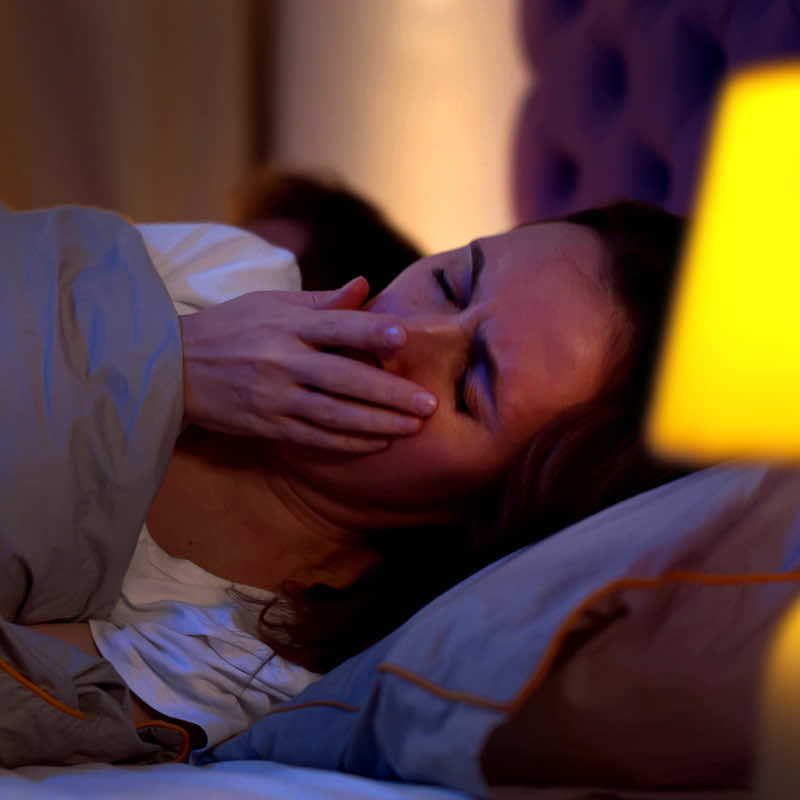Home / Why do I have a cough?
Why do I have a cough?
Coughing is a natural defence mechanism put in place by our body.
We all know its most irritating aspect, especially when it becomes more persistent. But in reality, coughing plays an important role that we need to be aware of and remember when dealing with it.
Whether it is a reflex or an involuntary action, coughing is nothing more than a forced manoeuvre to expel air from the lungs.
When we cough, we clear any foreign substances and/or irritants from the airways. A particularly important role is played by the mucosa of the upper airways. This is in fact our first protective barrier. As soon as it comes into contact with irritants, the mucosa triggers an alarm bell, becoming inflamed and causing coughing.


Dry cough or chesty cough: how to recognise them
There can be different types of cough, each of which has different origins and causes.
Dry cough: causes and symptoms
A dry cough is when there is no production of mucus or phlegm. In this case, the cough is triggered by irritation and inflammation of the upper respiratory tract by viruses, bacteria or irritants. It is particularly irritating and usually occurs in the first days of viral nose and throat infections.A dry cough may be accompanied by an irritated and itchy throat and occurs mainly at night, disturbing people’s sleep and causing tiredness and irritability during the day.
Dry cough: causes and symptoms
On the other hand, we talk about a chesty or productive cough when there is an increased production of mucus or phlegm. This type of cough can be the progression of a dry cough, when inflammation of the upper respiratory tract results in the production of thicker, more viscous mucus that drips from the nose into the pharynx, where it stagnates. A chesty cough can also be the consequence of acute and chronic infectious diseases of the lower respiratory tract (trachea, bronchi and lungs}, which cause mucus production. It is therefore important to take into account any other clinical signs that may accompany it, in particular, difficulty breathing and/or fever and/or purulent catarrh, and to consult the doctor in order to investigate the cause of the cough and receive the correct treatment.
Persistent or acute cough: what causes it?
In some cases, the cough can become more stubborn and just does not seem to want to go away. The discomfort caused by coughing becomes particularly unpleasant because it is prolonged over time. An acute cough is one that lasts for no longer than two weeks, and a persistent cough is when the problem lasts up to four weeks. A persistent cough may also be chesty or dry and can be caused by a variety of problems.
A cough becomes persistent when a vicious cycle is triggered, which causes us to become more susceptible to environmental situations (cold, dry and polluted environments) lowering the threshold of the urge to cough.
It is very important to take into account whether there are other symptoms accompanying the cough. In such cases, a doctor should be consulted to correctly identify the cause.


Coughing at night: why people cough more in bed
Unfortunately, the torment of a cough continues through the night. In fact, at night it can become even more irritating, to the point that we cannot sleep. This is as common in children as it is in adults. The constant urge to cough causes us to wake up repeatedly and interrupts sleep, which has a negative impact on our day.
Night-time cough: causes
Coughing at night: why people cough more in bed? The recumbent position certainly makes it less easy to breathe by encouraging compression of the airways. Airway function can be further complicated, especially in the presence of inflammation, phlegm and irritants, which increases the frequency of coughing. Furthermore, during sleep, mucus builds up in the airways and this produces a strong urge to cough. The habit of breathing through the mouth during sleep and dry environments can also cause dehydration of the mucosa of the upper airways, leading to irritation and then coughing. Finally, night coughs could be caused by contact with irritants (cigarette smoke} or allergens (components in detergents or fabric softeners, mites or pollen in the pillow…).
Cough in children
How often do we worry because our little one has a cough? It is a very common childhood complaint and can affect our day and even the night’s sleep of the entire family. In these cases, it is natural to ask: what should we do if our child has a cough?
The first thing to know is that a cough can be a symptom of different illnesses, so it is important to understand whether it is accompanied by other symptoms or not.
Coughing is very often associated with common acute upper respiratory tract infections, viruses and/or colds, and in these cases it is not a particular cause for concern. There may also be more limited cases in which coughing may indicate a more serious ongoing condition and it is therefore advisable to see a doctor.


Cough in children: types and causes
Coughs in children can be classified in different ways depending on whether one considers the cause, duration or characteristics.
When considering duration in children, an acute cough is defined as one that does not last for more than two weeks, while a chronic cough is defined as one that lasts more than four weeks. It is important to check the causes of a chronic cough because it can be caused by specific diseases such as gastro-oesophageal reflux, bronchial asthma, etc.
During term time in particular, paediatricians often see children with coughs that have persisted for a long time, even for months. Most frequently, this is not a chronic form of the condition but rather repeated and sometimes overlapping acute episodes caused by continuous exposure to the microbes children in school communities are subjected to (children can typically have up to 6-8 respiratory infections per year). This occurs mainly in children in the 2-4 year age group. As in adults, a dry cough is when there is no production of mucus or phlegm. This type of cough is particularly irritating, it is very common in children, and it usually occurs in the first days of viral nose and throat infections. Subsequently, the inflammation caused by the virus causes the nose to produce thicker, more viscous mucus that drips from the nose into the pharynx where it stagnates, causing the type of cough that in paediatric age is called productive. A child’s productive cough (also referred to as ‘chesty’ in common parlance) is therefore due to the child’s difficulty in swallowing and/or expectorating mucous secretions from the nose.
Cough in children: 2 things to pay attention to
- Unblock the child’s nose: younger children in particular are unable to clear their noses of secretions and this exacerbates post-nasal drip that runs into the throat.
- The position in which the child falls asleep: lying down increases the stagnation of mucus, stimulating the cough reflex.






 it
it fr
fr es
es pl
pl be
be bg
bg de
de el
el he
he pt
pt ro
ro tr
tr